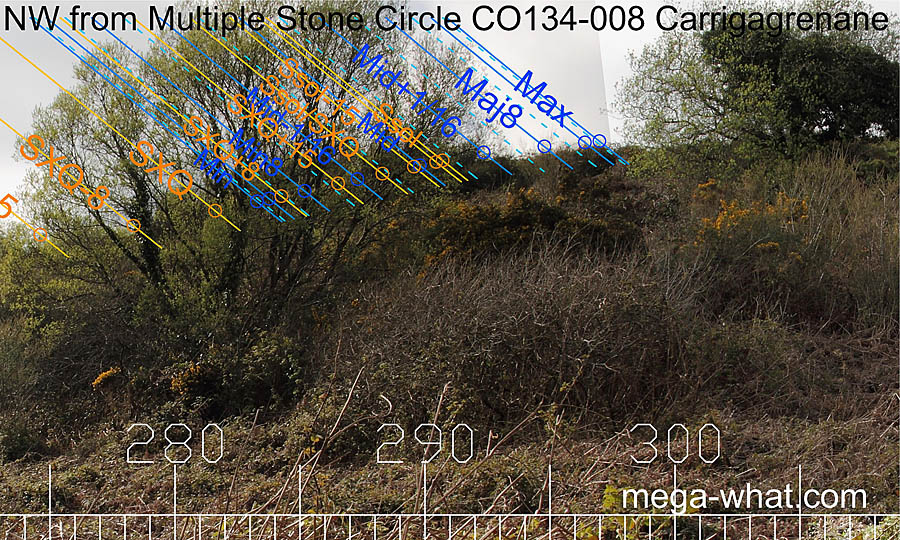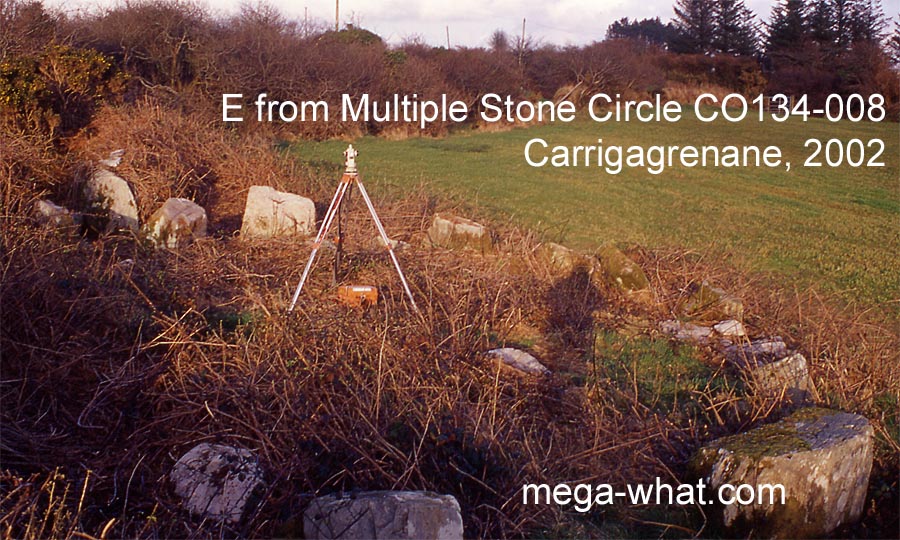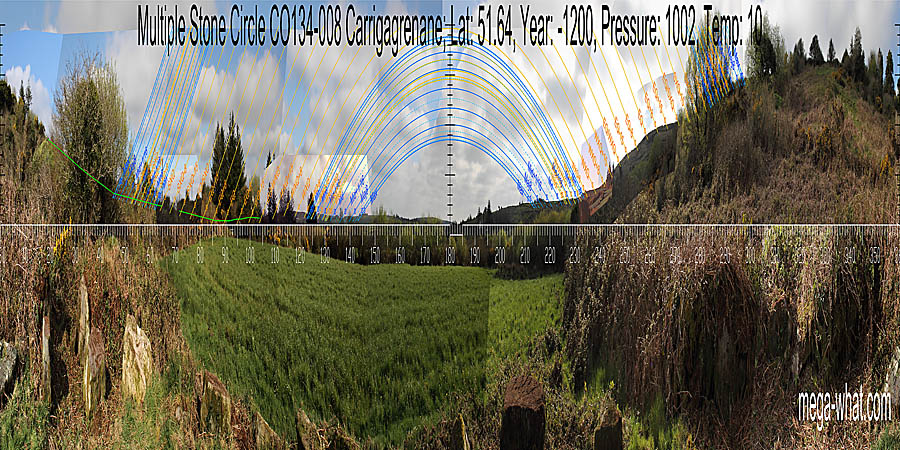 It is usually quoted as having 19 stones (the lunisticeLunistices are the most northerly and southerly moons of the month. The lunar equivalent of solstices - more.
range to the nearest whole number of years) but the structure is unusual.
Essentially, the circle consists of an axial-stone, 2 portals and 5 sidestones each side forming what is basically a 13 stone circle.
Additionally there is another radially set stone outside each portal and more stones have been inserted in the gaps of the south-east quadrant.
These extra stones could be later additions.
It is usually quoted as having 19 stones (the lunisticeLunistices are the most northerly and southerly moons of the month. The lunar equivalent of solstices - more.
range to the nearest whole number of years) but the structure is unusual.
Essentially, the circle consists of an axial-stone, 2 portals and 5 sidestones each side forming what is basically a 13 stone circle.
Additionally there is another radially set stone outside each portal and more stones have been inserted in the gaps of the south-east quadrant.
These extra stones could be later additions.
South is indicated by the lowest dip [Pic].
North appears to be on a slope but is obscured [Pic].
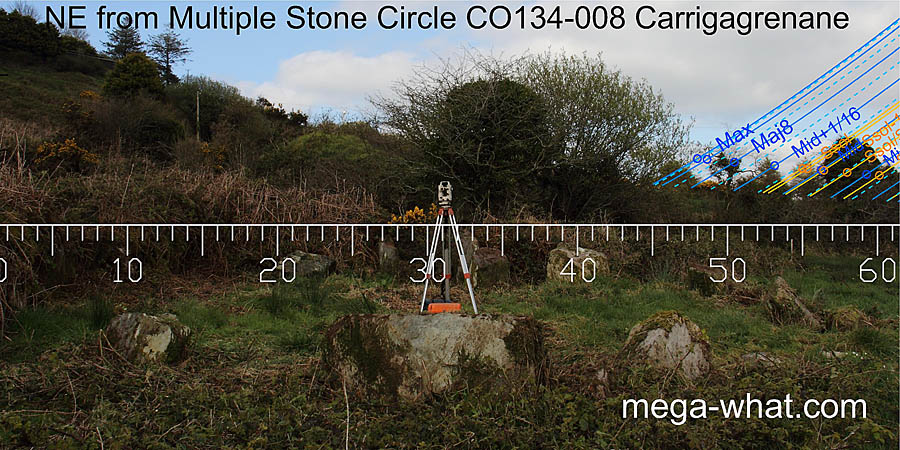 The reverse axis points up a steep hill to a featureless slope of no obvious significance.
However, the layout is interesting. The "exterior portals" splay out as one enters the circle. The north one touches the portal so there is no gap.
Between the south one and the circle, there is a gap wide enough to pass through and the stone's axis indicates the space between portal and first sidestone.
The line from between these two stones to the axial stone is the true axis of the circle and indicates the lunar maximum in both directions.
The reverse axis points up a steep hill to a featureless slope of no obvious significance.
However, the layout is interesting. The "exterior portals" splay out as one enters the circle. The north one touches the portal so there is no gap.
Between the south one and the circle, there is a gap wide enough to pass through and the stone's axis indicates the space between portal and first sidestone.
The line from between these two stones to the axial stone is the true axis of the circle and indicates the lunar maximum in both directions.
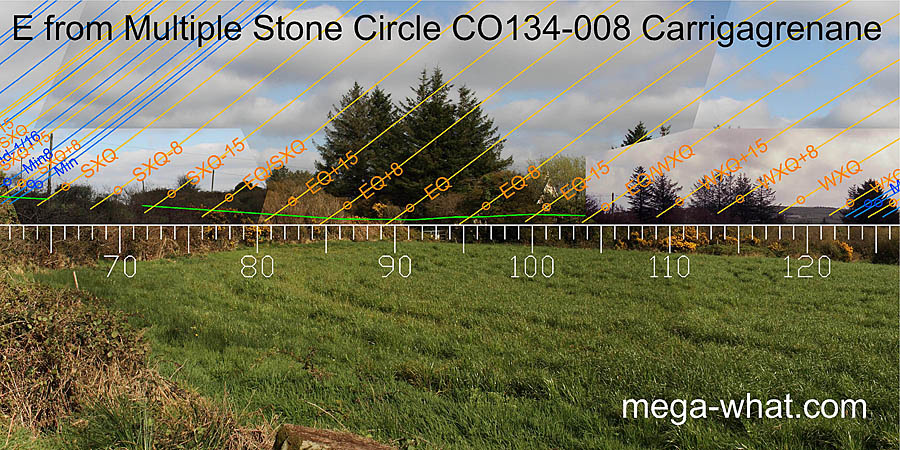 Vegetation makes the north-east and east unsurveyable except for a small gap in the bushes.
Vegetation makes the north-east and east unsurveyable except for a small gap in the bushes.
Further south along the horizon, the first feature just visible is a large dip or notch that is about halfway between the equinox and the winter cross-quarter.
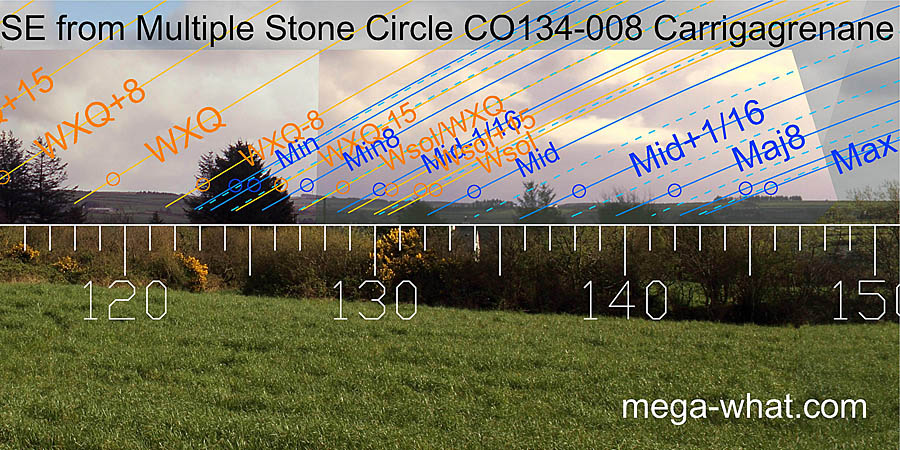 From the north-west side of the circle, the extra stones in the south-east perimeter indicate the span of the lunisticeLunistices are the most northerly and southerly moons of the month. The lunar equivalent of solstices - more.
range.
A dip largely obscured by a tree is the minor end of the cycle and the next large dip is a sixteenth beyond the midpoint.
A slight dip marks the major eighth and then the major end of the cycle falls at the top of the slope, in a stand of trees.
This hilltop is also axially indicated by Reenascreena Stone Circle,
which is visible a bit further west along the horizon with a declination of -33.6°.
For a hilltop that was targeted by two circles it is now rather poorly defined and one has to wonder whether there was once something rather more obvious there.
From the north-west side of the circle, the extra stones in the south-east perimeter indicate the span of the lunisticeLunistices are the most northerly and southerly moons of the month. The lunar equivalent of solstices - more.
range.
A dip largely obscured by a tree is the minor end of the cycle and the next large dip is a sixteenth beyond the midpoint.
A slight dip marks the major eighth and then the major end of the cycle falls at the top of the slope, in a stand of trees.
This hilltop is also axially indicated by Reenascreena Stone Circle,
which is visible a bit further west along the horizon with a declination of -33.6°.
For a hilltop that was targeted by two circles it is now rather poorly defined and one has to wonder whether there was once something rather more obvious there.
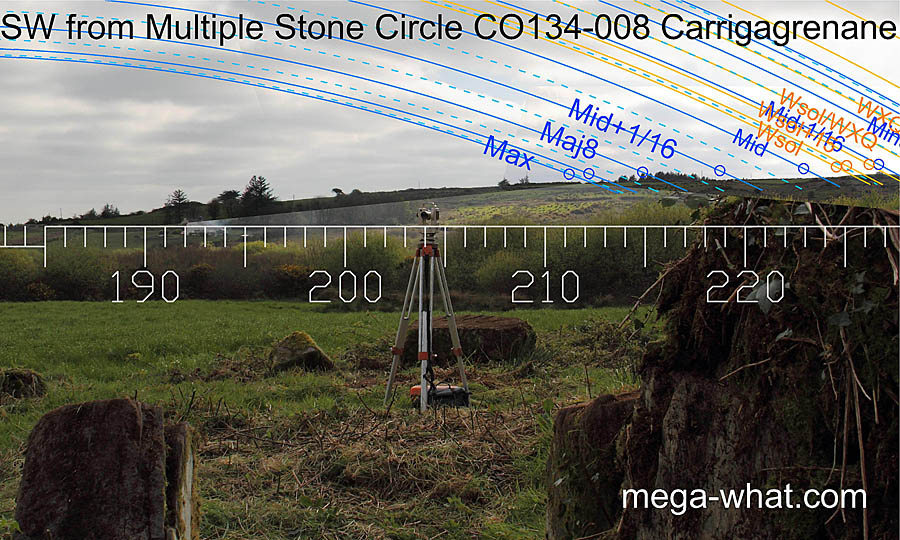
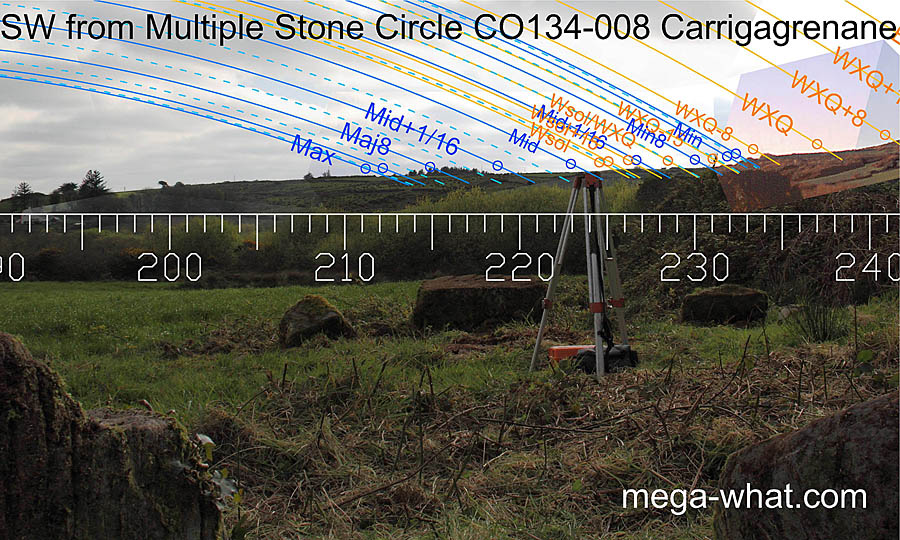 It seems to be a characteristic of circles with radially set portals that a line straight between the portal stones indicates a more southerly direction than the line from the portals to the axial stone.
Here, the theodolite is fairly accurately central. The first pic is through the portals, the next is from between the south portal and the adjacent sidestone.
It seems to be a characteristic of circles with radially set portals that a line straight between the portal stones indicates a more southerly direction than the line from the portals to the axial stone.
Here, the theodolite is fairly accurately central. The first pic is through the portals, the next is from between the south portal and the adjacent sidestone.
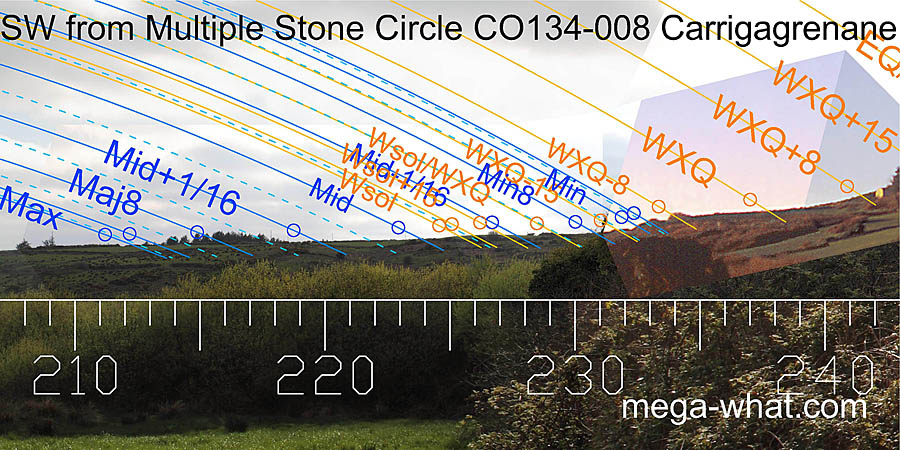 The minor end of the lunisticeLunistices are the most northerly and southerly moons of the month. The lunar equivalent of solstices - more.
range is marked by a notch/step that begins a bland grassy ridge that runs to its almost due south (182°) intersect with further horizons.
The circle's orthodox orientation towards this ridge yields a declination of about -31° or so with the lunar limit on the horizon above the north end of the axial stone.
The minor end of the lunisticeLunistices are the most northerly and southerly moons of the month. The lunar equivalent of solstices - more.
range is marked by a notch/step that begins a bland grassy ridge that runs to its almost due south (182°) intersect with further horizons.
The circle's orthodox orientation towards this ridge yields a declination of about -31° or so with the lunar limit on the horizon above the north end of the axial stone.
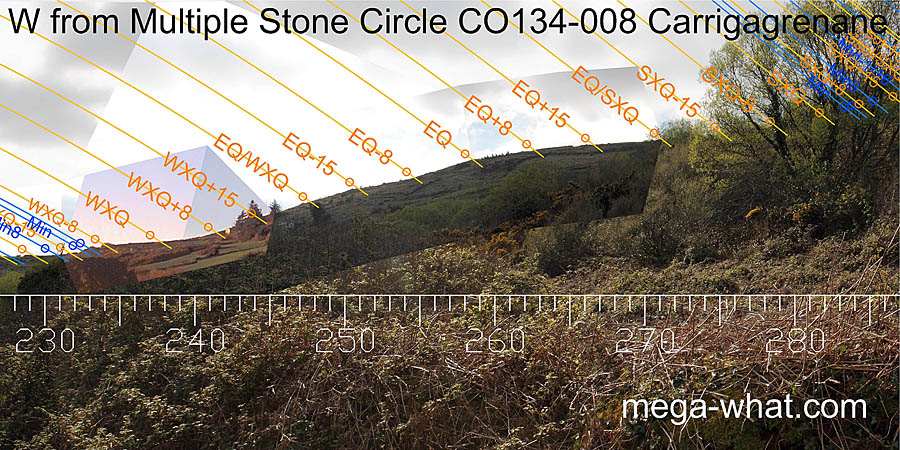 Equinoctially to the west is a small hump marking the start of the steep downward swoop of Carrig Fadda's flank.
The winter cross-quarters are at the foot of the slope and the halfway point between them is marked by a small hump on the slope.
Equinoctially to the west is a small hump marking the start of the steep downward swoop of Carrig Fadda's flank.
The winter cross-quarters are at the foot of the slope and the halfway point between them is marked by a small hump on the slope.
- Carrigagrenane Five Stone Circle is 700m north-east (46°)
- Reenascreena Stone Circle is 2.4km south-east (154°)
- Garryglass Stone Circle is 3.7km north-west (301°)
References
- Archaeological Survey of Ireland, record details. www.archaeology.ie/archaeological-survey-ireland
- BARBER, JOHN 1973 The Orientation of the recumbent-stone circles of the South-West of Ireland. Journal of the Kerry Historical and Archaeological Society 6:26-39, No.C23.
- Ó'NUALLÁIN, SEÁN 1975 The Stone Circle Complex of Cork and Kerry. Journal of the Royal Society of Antiquaries of Ireland 105:83-131, No.7.
- Ó'NUALLÁIN, SEÁN 1984 A Survey of Stone Circles in Cork and Kerry. Proceedings of the Royal Irish Academy 84c:1-77, p22, No.33.
- POWER, D. et al. 1992 Archaeological Inventory of County Cork, Volume 1: West Cork. Dublin: Stationary Office. p21, no.47.
- RUGGLES, C.L.N. 1999 Astronomy in Prehistoric Britain and Ireland. Newhaven & London: Yale University Press. No.ASC46.
- RUGGLES, C.L.N. & PRENDERGAST, F. 1996 A New Archaeoastronomical Investigation of the Irish Axial-Stone Circles. Proceedings of the 2nd SEAC [European Society for Astronomy in Culture] Conference, Bochum, 1994. Bochum: Astronomisches Institut der Ruhr-Universität. pp5-13.
- SOMERVILLE, BOYLE T. 1930 Five Stone Circles of West Cork. Journal of the Cork Historical and Archaeological Society 35:70-85.

